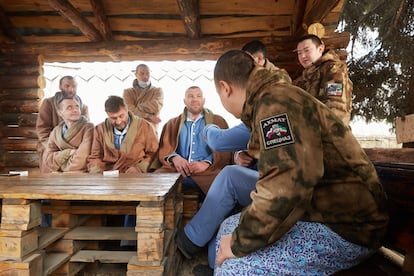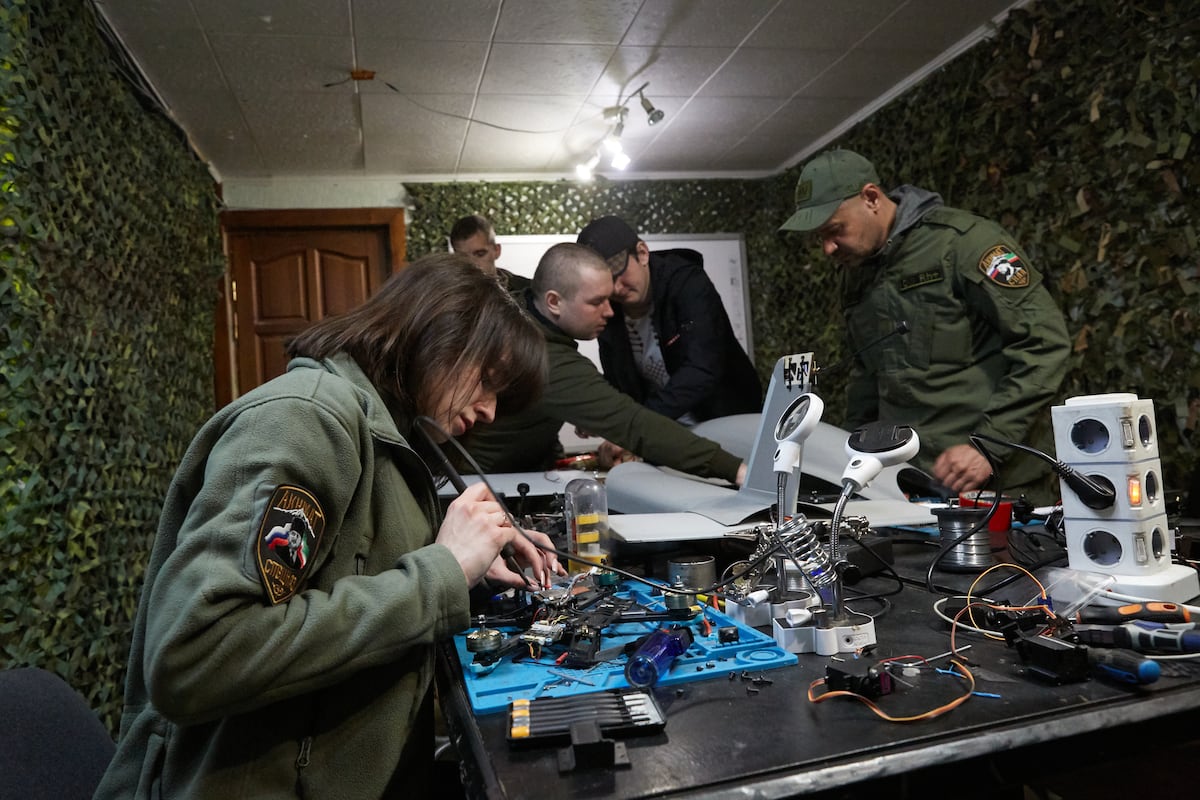The Wagner Group’s chief, Yevgeny Prigozhin, died two months after his failed 2023 rebellion against Vladimir Putin — after having been the Russian president’s trusted confidant — but his mercenary force did not disappear with him: thousands of Wagner veterans defected to the battalions of his ally against the Russian Defense Ministry, Ramzan Kadyrov, the head of the Chechen Republic.
Prigozhin, who ran a mercenary company and increasingly criticized the handling of the war in Ukraine, died in a plane crash widely suspected of being orchestrated. But his rebukes of Moscow remain in the conversations of his former soldiers at a hidden hospital in Luhansk (a territory in eastern Ukraine controlled by pro-Russian forces), members of the Akhmat regiment, named after Kadyrov’s murdered father. “If there’s one of our hospitals and another belonging to the Ministry of Defense, everyone tries to go to ours because we don’t abandon anyone,” one of their doctors told this newspaper.
The Russian High Command forced all independent units to integrate into the ranks of the regular army after the Wagner rebellion. However, Akhmat’s special forces still enjoy a degree of autonomy and are largely funded by Kadyrov, who, in addition to maintaining his Praetorian Guard, has gained much greater influence within the army and patriotic circles by expanding his forces with troops that are no longer exclusively Chechen, but rather volunteers from all over Russia.
“We are one country. From Moscow to the Urals and the Far East,” says Dobrynin, dressed in a medical gown alongside his comrades. He is a tall Akhmat soldier who participated in Operation Pipeline in mid-March during the recapture of the Russian town of Sudzha, in Kursk (a region of Russia partially occupied by Ukrainian forces). His unit, made up of around 30 newly enlisted Akhmat assault soldiers under the command of a former Wagner member, broke into the Ukrainians after advancing for six days along an abandoned gas pipeline, devoid of electricity and contaminated with gases and heavy metals. Doctors were shocked to see his white lungs on the scan.
“If it weren’t for our treatment, they would have quickly developed cystic fibrosis and lung cancer,” says Konstantin Florich, the hospital’s commanding officer, nicknamed “Bulya,” a Moldovan and former member of Wagner.
Bulya is responsible for 115 wounded, nine doctors, and a waiting list of more than 1,500 casualties. One of his doctors highlights the differences with other units: “We found the correct doses and offered our help to the other [Ministry of Defense] hospitals, but only one changed their treatment. Everyone thought they were doing well. We had to take our own patients away because their condition was deteriorating,” he explains, requesting anonymity.
 Doctors and patients at the hospital run by Akhmut, in Luhansk province. / Javier CuestaJAVIER CUESTA
Doctors and patients at the hospital run by Akhmut, in Luhansk province. / Javier CuestaJAVIER CUESTA
Flags bearing the face of Kadyrov’s father and Wagner’s skull hang in the hospital rooms. In one rest several members of Rusich, a Wagner reconnaissance group whose emblem is the Black Sun rune and which was founded by Yan Petrovsky, a well-known Russian neo-Nazi. One of his wounded men is Ecuadorian.
“I hadn’t fought before, I speak very little Russian,” Oriol, known as “Águila,” tells EL PAÍS. “I received military training in Ecuador. I came here out of vocation, not ideology,” he explains timidly, amid the jokes of his colleagues. The soldier was sent to the front in December and was shortly afterward wounded in a drone ambush in the battle for Toretsk, where he lost his hearing.
Toretsk, located in the western Donetsk region, is one of the hottest spots in the Ukrainian war. Drones are unforgiving in this devastated city and in neighboring Gorlovka, a dozen miles away and populated by civilians. Many soldiers treated at the hospital come from that front.
A surgeon, nicknamed “Diego,” and a nurse, “Malaya” (Little), remove shrapnel from the leg of Private Kiril Gromov, of the Fourth Motorized Brigade, a former militia from Luhansk. “I didn’t enlist for political or financial reasons, I just wanted to help the wounded,” explains Diego, a military doctor with a year and a half of experience. Now he performs one or two operations a day in the rearguard, but during the Bakhmut offensive, one of the bloodiest battles of the war, he operated on up to 10 seriously wounded people a day.
Today’s operation was easy; it was scheduled after the wounded man was stabilized in a field hospital on the front lines. Gromov was surprised by a drone, but managed to throw himself to the ground in time, his backpack protecting him. “The Ukrainians have changed the drone blades; now you can’t detect them from a distance, you can’t hear that horrible sound,” the soldier explains.
Zuchara, also a soldier in the Fourth Motorized Brigade, wanders around with a blank stare before being examined using expensive CT equipment paid for by Kadyrov, a device not available in other Defense Ministry hospitals. Zuchara was attacked two days earlier with an unidentified chemical weapon and his right lung was damaged. The young man was evacuated by his comrades; although he managed to escape the toxic cloud, he fainted.
“At Akhmat, we don’t consider the idea of having unsalvageable patients, soldiers who know for sure they’re going to die. We fight for everyone, we fight to the bitter end for each and every one of them. This is what I like about this unit,” says the doctor treating Zuchara, speaking on condition of anonymity.
Hospital commander Bulya emphasizes that this is how Akhmat differed from some of the Russian Armed Forces: “It was like that with Yevgeny Viktorovich [Prigozhin]; he visited the wounded and demanded that we prioritize the assault troops. That they be the VIPs, not the top brass. If there were 10 chocolate bars, nine would go to them and one to the doctors.”
Bulya says that this philosophy has continued after he defected to Akhmat. “Apti Aranovich [Alaudinov, Akhmat’s general] called me and asked me to save our guys.” “Apti Aranovich, Yevgeny Viktorovich, Grandfather Dmitry Utkin [military commander of Wagner, who died on the same plane as Prigozhin]… These are the kind of people who go all the way and don’t fight for power; they are competent commanders,” Bulya says. “These are the [commanders] the Russians love.”
Drones kill more than artillery and bullets combined
The hospital has an armored ambulance that looks like something out of the Mad Max saga due to its modifications. A huge vehicle with 150-kilogram doors, it has been hit by drones five times in 50 trips and has only lost a wheel once. “It’s a tempting target,” admits Bulya.
The Russian military insists that the threat from drones, present throughout the war, has become unbearable in the last two months. “I receive virtually no gunshot wounds, about 1% at most,” says Dr. Diego.
“Drones account for more than half of the deaths,” says Vasili, a drone unit commander with Akhmat, nicknamed “Psij.” “When I first saw a drone two years ago, I didn’t know what it was. War has completely changed; it’s more terrifying,” he adds.
His unit moves from house to house in the middle of villages to hide from the Ukrainian HIMARS. In one, they repair and modify their drones. “Killing a single enemy can save three of our own, plus the costs of training, hospitalization, or family compensation,” says Psij, explaining why it’s profitable to attack a single enemy soldier with a drone.
“The most dangerous drone is the fiber-optic cable drone,” notes another Akhmat commander, Fartobi. “Electronic countermeasures don’t affect them,” he adds, before explaining the only current responses to this type of warfare: “Try to remain undetected or flee into the forest. A competent pilot will make you run with your equipment to tire you out before striking.”
This Akhmat unit has all types of drones, from kamikazes to reconnaissance drones, and has trained more than 1,500 soldiers. “We observe that other [Russian] forces place less emphasis on practice. We practice with experienced instructors,” Psij emphasizes.
New recruits take part in a training session in the middle of the countryside. One of the bombs starts a fire in the parched grass. “Can I tell you why I joined the war?” asks Volodya, nicknamed “Tiopli” (Warm) and a local volunteer since 2014.
“I joined when Ukrainian forces fired on my village, on my two sons, there was no fighting there,” says Tiopli. Eleven years later, his eldest son is about to turn 18, the age for military service. “I don’t care about pride, I don’t wish my children the fate I suffered, I’m tired,” says the 45-year-old veteran. “For the Ukrainians, I was a moskal (a derogatory word for Muscovite), and for the Russians, a jojol (a derogatory word for Ukrainian). All of this could have been resolved diplomatically,” he laments.
For Tiopli, the goal must be peace, “not Kyiv.” “We want to live freely, but this also depends on Ukraine,” adds Andrei, a twenty-something nicknamed “Student.”
Sign up for our weekly newsletter to get more English-language news coverage from EL PAÍS USA Edition
